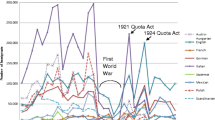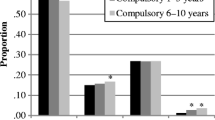Abstract
This paper explores the role of assortative matching on education in explaining the relationship between schooling and ethnic endogamy. Using 2000 US Census data, we find that matching on education rather than ethnicity is more important for natives than for the foreign born and for the foreign born who arrived as young children rather than for those who arrived as teenagers. Education does not appear to influence the marriage decisions of Asians, but matching on education plays a larger role in the decisions of whites than those of Hispanics.
Similar content being viewed by others
Notes
We use the words ethnicity and ancestry interchangeably throughout the paper.
Although Borjas did not specifically consider marriage patterns as a mechanism through which ethnic externalities operate, Becker and Murphy (2000) suggest that marital sorting on education, income, race, and religion is more important in transmitting inequality than neighborhood segregation.
These three mechanisms can be framed in a manner consistent with Wong (2003) and Gullickson (2006). What we call cultural adaptability and Gullickson calls structural assimilation theory can be interpreted as the effect of education on Wong’s mating taboo. By what we call the enclave effect and Gullickson calls isolation theory, Wong might describe as education decreasing the opportunities for courtship between immigrants of the same ethnicity. Lastly, by what we call the assortative matching effect, Wong could say that more education decreases the differences in endowments between people of different ancestries. Although Gullickson does not emphasize the role of assortative matching, he controls for the different educational distributions of blacks and whites in his empirical analysis.
In 1970, 16.5% of the US population were either foreign born or had at least one foreign born parent, while in 2000, the figure increased to 20.4% (Schmidley 2001). Although immigrant educational attainment has increased in absolute terms since 1970, relative to natives, immigrant schooling levels have declined rather substantially, most notably at the bottom end of the education distribution (Betts and Lofstrom 2000). In 1970, over 70% of the foreign born were non-Hispanic white, while by 2000, about half were Hispanic and a quarter Asian (Gibson and Jung 2006).
For example, demand for family vacations in the home country or dinners at ethnic restaurants will certainly be affected by ancestry. Examples of household public goods that might be affected by education include visits to museums or intellectual conversations.
Alternatively, we can assume that marriage market participants always prefer more education in a spouse to less. In this scenario, equilibrium sorting in the marriage market will also result in assortative matching on education.
As a specification check, we dropped from the same people over the age of 40 years in order to reduce any bias resulting from the possibility that endogamous marriages are less likely to end in divorce (Kalmijn 1998). Our results were robust.
Concerned about reverse causality between education and endogamy, we would have liked to examine whether results were robust to excluding people who married young. Unfortunately, age at first marriage is not available from the 2000 Census. However, since most people have their first child shortly after marriage, we experimented with dropping from the sample those who had their first child younger than age 30 years. Again, results were robust. Moreover, even without putting any age restrictions on the data, only 15% of all married people acquire more education after marriage (Lewis and Oppenheimer 2000).
We also examined marriages of people who list only one ancestry, and results were robust.
Because approximately 93% of Spaniards self-identify as Hispanic, we consider Spaniard a Hispanic ancestry. For which ancestries are considered white, Hispanic, and Asian, see Table 1.
As suggested by Fryer (2007) as well as Chiswick and Houseworth (2008), the military forces its members to associate with individuals from many ethnic and racial backgrounds, and so, veterans may feel more comfortable with exogamous marriages. It may also be that veterans exhibit greater attachment to the host country relative to their home countries, which could also lead to lower endogamy rates.
A possible concern with the size variables is that people choose whether to live amidst a large number of coethnics potentially as a result of whom they marry. We address this issue, at least for the native-born population, by calculating the size of the ethnic group in a person’s state of birth as opposed to MSA of current residence. Since state of birth is chosen by one’s parents, it is arguably less endogenous to marriage choice. Moreover, it is certainly not subject to reverse causality concerns. Qualitative results did not change when this different measure was used.
Our foreign born sample consists only of immigrants arriving in the USA before the age of 18 years. We also ran the regression using the entire foreign-born population. The coefficient on the interaction was almost the same.
References
Bartel AP (1989) Where do the new U.S. immigrants live? J Labor Econ 7(4):371–391
Becker GS (1973) A theory of marriage: part I. J Polit Econ 81(4):813–846
Becker GS, Murphy KM (2000) Sorting by marriage. In: Becker GS, Murphy KM (eds) Social economics: market behavior in a social environment. Belknap/Harvard, Cambridge, MA, pp 29–46
Betts JR, Lofstrom M (2000) The educational attainment of immigrants: trends and implications. In: Borjas G (ed) Issues in the economics of immigration. University of Chicago Press for National Bureau of Economic Research, Inc., Chicago, pp 51–116
Bleakley HC, Chin A (2010) Age at arrival, English proficiency and social assimilation among U.S. immigrants. Am Econ J: Appl Econ 2(1):165–192
Borjas GJ (1992) Ethnic capital and intergenerational mobility. Q J Econ 107(1):123–150
Borjas GJ (1995) Ethnicity, neighborhoods, and human capital externalities. Am Econ Rev 85(3):365–390
Borjas GJ (1998) To ghetto or not to ghetto: ethnic and residential segregation. J Urban Econ 44(2):228–253
Chiswick B (2009) The economics of language: an introduction and overview. In: Wiley TW, Sook Lee J, Rumberger RW (eds) Immigration, language and education. Multilingual Matters Ltd, Clevedon, UK
Chiswick B, DebBurman N (2004) Educational attainment: analysis by immigrant generation. Econ Educ Rev 23(4):361–379
Chiswick B, Houseworth C (2008) Ethnic intermarriage among immigrants: human capital and assortative mating. IZA Discussion Papers 3740. Institute for the Study of Labor (IZA), Bonn
Constant AF, Zimmermann KF (2008) Measuring ethnic identity and its impact on economic behavior. J Eur Econ Assoc 6(2–3):424–433
Constant AF, Gataullina L, Zimmermann KF (2009) Ethnosizing immigrants. J Econ Behav Organ 69(3):274–287
Crissey SR (2009) Educational attainment in the United States: 2007, current population reports, special studies, series P20–560. US Department of Commerce, Economics and Statistics Administration, US Census Bureau, Washington, DC 20233
Duncan OD, Lieberson S (1959) Ethnic segregation and assimilation. Am J Sociol 64(4):364–374
Federman MN, Harrington DE, Krynski KJ (2006) Vietnamese manicurists: are immigrants displacing natives or finding new nails to polish? Ind Labor Relat Rev 59(2):302–318
Friedberg RM (1992) The labor market assimilation of immigrants in the US: the role of age at arrival. Brown University mimeo, December
Fryer RG Jr (2007) Guess who’s coming to dinner? Trends in interracial marriages over the 20th century. J Econ Perspect 21(2):71–90
Furtado D (2006) Human capital and interethnic marriage decisions. IZA Discussion Paper 1989. Institute for the Study of Labor (IZA), Bonn
Gibson C, Jung K (2006) Historical Census statistics on the foreign-born population of the United States: 1850–2000. Population Division Working Paper No. 81. US Census Bureau, Washington, DC 20233–8800
Gullickson A (2006) Education and black–white interracial marriage. Demography 43(4):673–689
Kalmijn M (1998) Intermarriage and homogamy: causes, patterns, trends. Annu Rev Sociology 24(1):395–421
Lam D (1988) Marriage markets and assortative mating with household public goods: theoretical reasons and empirical implications. J Hum Resour 23(4):462–487
Lazear EP (1999) Culture and language. J Polit Econ 107(S6):S95–S126
Lewis SK, Oppenheimer VK (2000) Educational assortative mating across marriage markets: non-Hispanic whites in the United States. Demography 37(1):29–40
Merton RK (1941) Intermarriage and the social structure: fact and theory. Psychiatry 4:361–374
Qian Z (1997) Breaking the racial barriers: variations in interracial marriage between 1980 and 1990. Demography 34(2):263–276
Ruggles MS, Alexander T, Fitch CA, Goeken R, Hall PK, King M, Ronnander C (2008) Integrated public use microdata series: version 4.0 [Machine-readable database]. Minnesota Population Center [producer and distributor], Minneapolis, MN
Schaafsma J, Sweetman A (2001) Immigrant earnings: age at immigration matters. Can J Econ 34(4):1066–1099
Schmidley DA (2001) Profile of the foreign born population in the United States: 2000. US Census Bureau, Current Population Reports, Special Studies, Series P23–206. US Government Printing Office, Washington, DC
Wong L (2003) Why do only 5.5% of black men marry white women? Int Econ Rev 44(3):803–806
Acknowledgements
The authors gratefully acknowledge suggestions provided by Yoo-Mi Chin, S. Djajic, Andrew Foster, Rachel Friedberg, Kaivan Munshi, Irina Paley, Shannon Seitz, Almudena Sevilla-Sanz, Stephen Trejo, Thorsten Vogel, Myeong-Su Yun, and conference participants at the 2008 Meetings of the Society of Labor Economists, the European Society of Population Economics, and the Population Association of America. We also thank two anonymous referees for very helpful comments. The usual caveat applies.
Author information
Authors and Affiliations
Corresponding author
Additional information
Responsible editor: Klaus F. Zimmermann
Electronic Supplementary Material
Below is the link to the electronic supplementary material.
APPENDIX
(PDF 204 KB)
Rights and permissions
About this article
Cite this article
Furtado, D., Theodoropoulos, N. Interethnic marriage: a choice between ethnic and educational similarities. J Popul Econ 24, 1257–1279 (2011). https://doi.org/10.1007/s00148-010-0319-7
Received:
Accepted:
Published:
Issue Date:
DOI: https://doi.org/10.1007/s00148-010-0319-7




